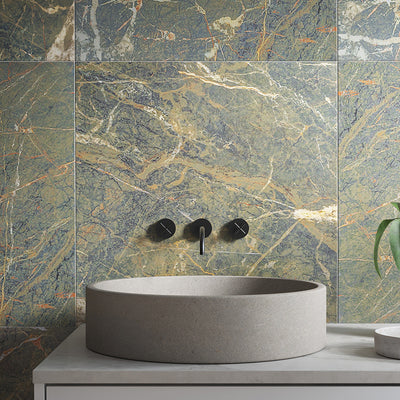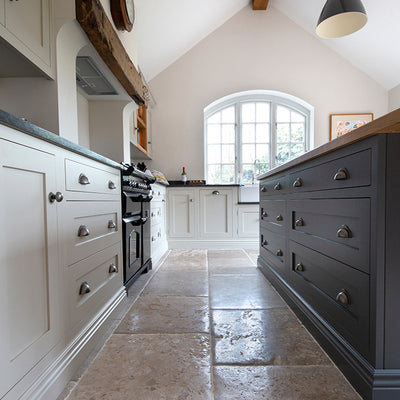How to Remove Stains from Natural Stone Tiles
In this guide we’ll cover how to remove stains from natural stone tiles. A wonderful feature of natural stone is its forgiving nature, thanks to natural markings, fossils, and tonal variation from tile to tile. Whilst many may worry that it is hard to clean and look after natural stone tiles, we have a few helpful tips and steps to follow should specific staining or contamination occur – ensuring your natural stone floor is well-maintained and cared for. For everyday maintenance, read our guide on how to clean natural stone tiles.
Removing Acidic Stains
Natural stone floor tiles are dense and hardwearing; whilst sealant can protect natural stone against many day-to-day spills, it cannot protect against harsh chemicals or acidic spills. This includes things like wine, orange juice, lemon, coffee and puppy accidents! The effectiveness of removing acidic stains will be dependent on the severity of the spill, the acidic content and time left on the surface.
In the first instance, the spillage should be flushed with water immediately - on occasion this can be enough to prevent etching the stone. Wipe the tile clean with a white towel and assess the mark (if any). If aesthetically noticeable, we recommend using Lithofin Power-Clean.
Start initially with a 1:10 ratio, apply generously to the whole tile (not just the mark) and leave the product on for 8-10 minutes - scrubbing every minute with a stiff brush or white emulsifying pad. Rinse twice with clear water and towel dry or wet vac the tile before assessing the results. If you are not satisfied, increase the ratio (1:8 or 1:3) of the product to water and test again. We do not recommend using this product neat.
The reaction between red wine acidity and Lithofin Power-Clean can cause a purple or blue toned mark on the tile. If this is the case, spray Lithofin Mildew Away on to the area for 10 - 20 seconds and completely remove with water and a stiff brush.
Removing Oil Stains
Similarly to acidic stains, sometimes oil staining can occur (such as by the cooker). Whilst sealant can protect natural stone against many day-to-day spills, it cannot protect against all oil contamination. The effectiveness of removing oil stains will be dependent on the severity of the spill, if the sealant is still intact, and time the oil is left on the surface.
In the first instance, the spillage should be flushed with water immediately - on occasion this can be enough to prevent staining the stone. Wipe the tile clean with a white towel and assess the mark (if any).
We recommend using Lithofin OIL-EX as a cleaning method – you may need to deep clean the tiles with Lithofin Power Clean for larger oil stains prior to this. Begin by testing the product on one stubborn oil spot. Start by removing any solid and surface soiling with a stiff brush. Apply Lithofin OIL-EX to the dry surface using a spatula, so that a coating thickness of at least 2mm is achieved. Allow to dry for approximately 12 hours. The remaining powder can be brushed off after it is completely dry.
Deep Cleaning Tiles
Whilst natural stone tiles are forgiving and durable, it is necessary to maintain them correctly to keep them looking their best. There is no rule on the frequency as it comes down to usage and personal preference, but some level of deep cleaning is occasionally required.
For a deep floor clean, we recommend using the Lithofin Power-Clean, designed to remove stubborn dirt, oil, and grease. Begin by testing the product on two affected tiles using the following method. To work out the correct ratio of product to water for your floor, we recommend testing the product on a tile in a discreet area with a ratio of 1:10. Apply generously and leave the product on for 8-10 minutes - scrubbing every minute with a stiff brush. Rinse several times with clear water and towel dry before assessing the results.
If you are not satisfied, increase the ratio of product to water and test again. We do not recommend using this product neat and it is always best to work in small controlled sections (2-3m2 at a time).
Should you require further advice on cleaning or maintenance, please contact the Lithofin technical helpline on 01962 732 126.
Always follow manufacturers guidelines. We recommend conducting a test in a discreet area prior to a full application of the product. Wear appropriate clothing and protective wear, such as gloves and glasses. Always keep pets and children away from any treated areas until the product has been removed.
If you found this post helpful, we also have guidance on how to clean natural stone tiles and how to clean outdoor natural stone paving as part of our series on natural stone tiles.







